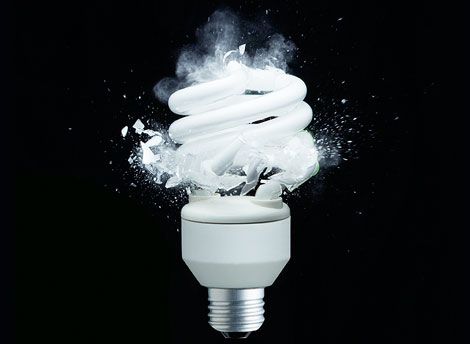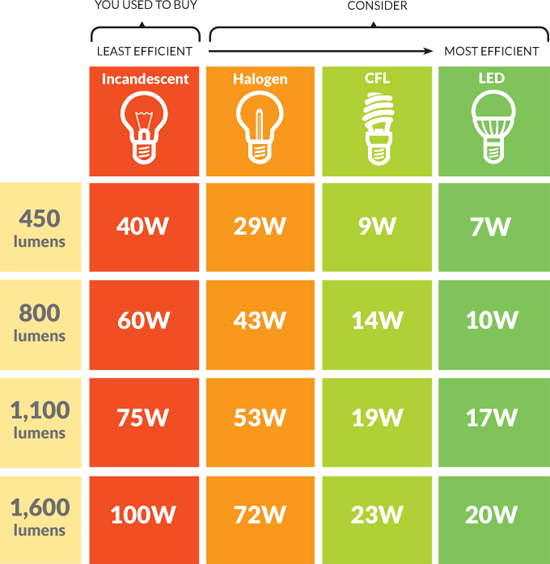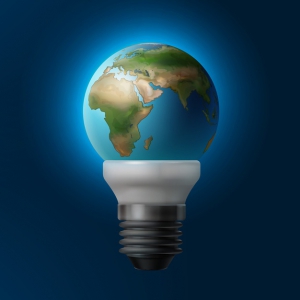We work with your local utility company and government to maximize incentives to help with the cost for you to go green. We support a diversified workforce and strive to bring a wide variety of ideas together to help our customers meet their energy goals. We are your energy efficiency advocate. We promote energy efficiency by helping businesses move toward energy independence in order to promote a healthier economy, a cleaner environment, and energy security.
New Lightbulbs: What’s the Difference?
Traditional incandescent bulbs use a lot of energy to produce light and are no longer manufactured.
- 90% of the energy is given off as heat
- That lost energy is money we are throwing away
Newer energy-saving lightbulbs provide the choices in colors and light levels you’ve come to expect. The new lights are also much more efficient — so they save you money.
What Are My Lighting Choices?
You have many choices in energy-efficient lighting. The most popular light bulbs available are halogen incandescents, compact fluorescent lamps (CFLs), and light-emitting diodes (LEDs). Although they can initially cost more than traditional incandescent bulbs, during their lifetime they save you money, because they use less energy. You can find these in most hardware and home improvement stores.
Controls such as timers and photocells save electricity by turning lights off when not in use. Dimmers save electricity when used to lower light levels. Be sure to select products that are compatible with the energy-efficient bulbs you want to use.
If you have outdoor lighting that is left on for a long time, using CFLs or LEDs in these fixtures will save a lot of energy. Most bare spiral CFLs can be used in enclosed fixtures that protect them from the weather. CFLs and LEDs are available as flood lights. These models have been tested to withstand the rain and snow so they can be used in exposed fixtures. Also look for ENERGY STAR-qualified fixtures that are designed for outdoor use and come with features like automatic daylight shut-off and motion sensors.

Halogen Incandescents
Halogen incandescents have a capsule inside that holds gas around a filament to increase bulb efficiency. They are available in a wide range of shapes and colors, and they can be used with dimmers. Halogen incandescent bulbs meet the federal minimum energy efficiency standard, but there are now many more efficient options to meet your lighting needs.

CFLs
Compact fluorescent lamps (CFLs) are simply curly versions of the long tube fluorescent lights you may already have in a kitchen or garage. Because they use less electricity than traditional incandescents, typical CFLs can pay for themselves in less than nine months, and then start saving you money each month. An ENERGY STAR-qualified CFL uses about one-fourth the energy and lasts ten times longer than a comparable traditional incandescent bulb that puts out the same amount of light. A typical CFL can pay for itself in energy savings in less than 9 months and continue to save you money each month. A CFL uses about one-third the energy of a halogen incandescent.

LEDs
Light emitting diodes (LEDs) are a type of solid-state lighting — semiconductors that convert electricity into light. Although once known mainly for indicator and traffic lights, LEDs in white light, general illumination applications are one of today’s most energy-efficient and rapidly-developing technologies. ENERGY STAR-qualified LEDs use only 20%–25% of the energy and last 15 to 25 times longer than the traditional incandescent bulbs they replace. LEDs use 25%–30% of the energy and last 8 to 25 times longer than halogen incandescents.
LED bulbs are currently available in many products such as replacements for 40W, 60W, and 75W traditional incandescents, reflector bulbs often used in recessed fixtures, and small track lights, desk lamps, kitchen undercabinet lighting, and outdoor area lights. They come in a variety of colors, and some are dimmable or offer convenient features such as daylight and motion sensors. LEDs work well indoors and outdoors because of their durability and performance in cold environments. Look for LED products such as pathway lights, step lights, and porch lights for outdoor use. You can also find solar-powered outdoor lighting.
While LEDs are more expensive, they still save money because they last a long time and have very low energy use. As with other electronics, prices are expected to come down as more products enter the market.

Here is how the most common types of bulbs compare:

* Annual cost of operation based on 800 lumens for 2 hours per day at $0.16 per kWh. ** CFLs and LEDs require compatible dimmers.
Brightness and Efficiency
Because bulbs vary in their efficiency, it’s best to compare bulbs based on their light output (lumens) rather than their wattage (amount of energy used). The higher the number of lumens, the brighter the light will be. Higher wattage bulbs use more energy. Here’s how bulbs compare:

Shape Choices

A-Line (e.g., A19, A21, or omni directional) bulbs disperse light at a wide angle and are ideal for fixtures used to spread light throughout the room. A-line bulbs are a good choice for room area-lighting, reading lamps, and hallways.
 A-Line (e.g., A19, A21, or omni directional) bulbs disperse light at a wide angle and are ideal for fixtures used to spread light throughout the room. A-line bulbs are a good choice for room area-lighting, reading lamps, and hallways.
A-Line (e.g., A19, A21, or omni directional) bulbs disperse light at a wide angle and are ideal for fixtures used to spread light throughout the room. A-line bulbs are a good choice for room area-lighting, reading lamps, and hallways.
 Floodlights (e.g., PAR20, PAR30, etc.) cast a wider directional light than spotlights. Floodlights are ideal for recessed lighting, outdoor lighting, landscape lighting, and motion sensors.
Floodlights (e.g., PAR20, PAR30, etc.) cast a wider directional light than spotlights. Floodlights are ideal for recessed lighting, outdoor lighting, landscape lighting, and motion sensors.
 Candelabra and Miniature Candelabra bulbs (e.g., E11, E12, etc.) imitate the shape of a candle and provide ambient and accent lighting. They are for use in decorative lighting fixtures, including wall sconces, decorative fixtures and chandeliers.
Candelabra and Miniature Candelabra bulbs (e.g., E11, E12, etc.) imitate the shape of a candle and provide ambient and accent lighting. They are for use in decorative lighting fixtures, including wall sconces, decorative fixtures and chandeliers.

